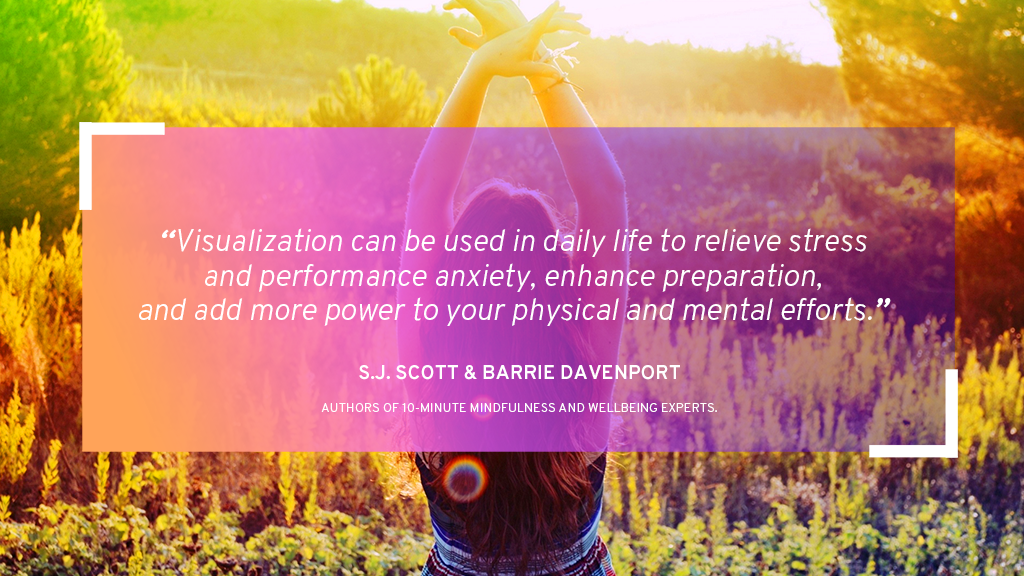Wishing to unplug your mind from the outside world and put a stop to daily stress? Contrary to conventional wisdom, you don’t need to spend thousands on a spa retreat or a long-due vacation. What you need is visualization. Through visualization or visual thinking, the mind is capable to achieve a deep relaxation response by creating a powerful image. Scientific research has revealed that thoughts produce the same mental instructions as actions, unlocking many benefits such as the ability to manage stress better and the confidence to fulfill your personal goals.
For years, visualization has been associated with conditioning our brains to achieve success and accomplishing our biggest dreams. High-achievers hyper concentrate in their desires with confidence to make their ambitions come true. It isn’t a super-power; what they are doing is activating their creative subconscious to start generating creative ideas and reprogramming their brains to perceive valuable resources. That’s why, if you visualize yourself winning a sports match or excelling at an academic test, you will have more chances of making the visualization come true.
Businessman and author, Harvey Mackay spoke about the benefits of visualization by saying:
“I believe that visualization is one of the most powerful means of achieving personal goals.”
And, although many more testimonies and research have reaffirmed the relationship between visual thinking and personal accomplishments, the perks of creative visualization practice do not end there. In fact, visualization has the power to help us finding internal quietness and reaching a deep state of relaxation whenever we need it most.
So… What is visualization and how can visual thinking change your life?

Visualization is the act of creating a strong, detailed mental image or thought about a peaceful and attractive setting or environment. It is also a vital part of meditation. Along with focus and determination, the emotion that the imaginary setting evokes becomes dynamic and powerful, ultimately allowing us to relieve stress and get rid of negative, unwanted thoughts.
The practice of visualization is nothing new; it gained popularity in the late seventies and early eighties as an effective technique for personal development. Nowadays, well-known personalities such as Oprah Winfrey, Will Smith, and Lindsey Vonn link their personal journeys of improvement and remarkable accomplishments to the constant practice of visualization.
Why relaxing your mind is important

Stress is a natural mental and physical reaction to life experiences. Everyone deals with stress from time to time. Avoiding it is nearly impossible; personal relationships, the death of a loved one, an unexpected diagnosis and many more unpleasant situations can trigger stress. Of course, many would say that stress is actually quite good as it inspires us to push ourselves a bit more to reach our full potential. Yet, stress is a double-edged sword; high levels of stress can take negative tools on our mental and physical health.
On a mental and emotional level, stress can cause racing thoughts, constant worrying, difficulty concentrating, and difficulty making decisions. Additionally, people dealing with stress often feel overwhelmed, irritable and wound up, anxious or fearful and lacking in self-esteem. Therefore, we all need a way to achieve mind relaxation and effective stress management. For many, this is visualization.
Tell me more about stress management
Visualization to achieve success in all areas of life

You can apply visualization to relax and excel in any aspects of your personal and professional life. In the world of competitive sports, for example, athletes do not only need outstanding physical skills, but also a strong mental game. The majority of coaches agree that sports are 90% mental and only 10% physical. This is why so many athletes train themselves in visualization or mental imagery alongside their physical training routines. Athletes start the routine by visualizing a good day. In their visualizations, they wake up with a positive state of mind, prepare for the competition and perform exactly how they desire — fully exploding their physical capacities and claiming victory. The positive visualization has many benefits, among them relaxation and the ideal mindset to excel in the respective discipline.
Veteran American freestyle skier and three-time Olympian, Emily Cook, has opened about the many benefits of meditation with a focus on visualization. She has described how her detailed imagery scripts and mental rehearsal involving all the senses has helped her to maintain a long and recognized career in her sports field.
“Visualization, for me, doesn’t take in all the senses. You have to smell it. You have to hear it. You have to feel it, everything.”
Cook adds: “I would say into a [tape] recorder: ‘I’m standing on the top of the hill. I can feel the wind on the back of my neck. I can hear the crowd,’ kind of going through all those different senses and then actually going through what I wanted to do for the perfect jump…”
Like Cook, more and more people attribute the benefits of meditation and their success to visualization. Regarding their diverse backgrounds, it is undeniable that those who visualize are capable of achieving new heights and milestones in their personal lives regardless of age, gender, and career. What’s more, their effective visual thinking is helping them to put a stop to one of the factors that jeopardize human beings’ success and makes relaxation even harder: stress.
A life-changing habit for all: mind relaxation and stress management

When human beings experience dangerous doses of stress, our physiology acts accordingly with our bodies triggering a cascade of hormones, which result in an acceleration of our heart rate, tension of the muscles, difficulty to breathe, dilated pupils and much more. This combination of reactions to stress is widely known as the fight-or-flight response because it evolved as a mechanism of survival. This near instantaneous chain of hormonal changes and physiological responses help us either flight the treat or flee to safety. Unfortunately, the body can also overreact to the stressful situations that aren’t necessarily life-threatening, a traffic jam, a work interview, an exam, etc. So we need stress management in all areas of our lives.
Luckily, our bodies are equipped with a built-in stress defense mechanism known as the parasympathetic nervous system. Stress relief, effective stress management and basically, our ability to stay free of anxiety is directly linked to the activation of this system. Over the years, many scientific studies have associated meditation with the activation of the parasympathetic nervous systems. The benefits of meditation are many. When we meditate, not only does the brain change in a physiological way; it changes the chemistry of your main thinking organ, and the actual brainwaves too. When you meditate, your brainwaves change from alpha and beta (alert) to gamma and delta (relaxed) waves. Our sympathetic nervous system becomes immediately engaged in creating a variety of physiological changes, including increased metabolism, heart and breathing rate, blood pressure, dilation of pupils, and constriction of our blood vessels.
All that work enables us to fight or flee from a stressful or dangerous situation and it is known as the relaxation response. This term was coined by Dr. Herbert Benson, professor, author, cardiologist, and founder of Harvard’s Mind/Body Medical Institute. A great body of research has proven that the activation of the Relaxation Response can help any health problem that is caused or exacerbated by chronic stress such as insomnia, hypertension, anxiety disorders, and others. According to Dr. Benson, one of the most important things in order to elicit the Relaxation Response is learning how to quiet our minds and gain inner peace through meditation.
Tell me more about how to manage anxiety
Where to start with visual thinking for relaxation: Visualization techniques

Visualization through meditation is a practice that demands dedication and concentration. For many, it can be quite difficult to achieve. Staying still and conjuring a mental image out of nowhere is not easy as it might sound and visualization beginners can feel quite overwhelmed and lost initially. A good way to start the journey of visualization is to go somewhere quiet and private where you won’t feel disrupted. Once there, it is essential to close your eye and project the object or place with as much detail as possible. Add emotion, feeling, sensation and senses to your vision. If you are feeling stuck, here are some simple techniques, which might aid your visualization.
Calm beach scene technique
This technique is normally used when you are on a plane and there’s no chance of getting off. Your mind might start wandering and going through all possible scenarios in which something goes terribly wrong. The best thing to do is to visualize yourself on a beautiful beach; lying on white sand, looking at a clear blue sky and gently lapping waves. Imagine your body is in touch with the sand; your fingers touch the sand and feel its warmth and texture. Breath in time with the rolling waves and let go of any tension.
Tell me about fighting with jet lag
Double-paned window technique
Sometimes, when we want to rest, take a good nap or sleep, there is something holding us up. Anxious thoughts begin to flow, preventing us from taking that well-deserved rest. Luckily, there is a special technique, which helps us relax when we are feeling stressed out about the future or our daily responsibilities. This is the double-paned window technique and it starts by visualizing lots of people chatting loudly outside your open window. Instead of exploding and shouting at them, you take control. You simply close your window and notice how the noise ceases.
Tell me more about improving sleep
Blue light technique
Light visualizations are popular relaxation techniques, especially useful when we are about to tackle an important and complex task or when we need to decompress after finishing them. The first step is to visualize yourself surrounded by a glowing orb of intense, blue light. You will then breathe in the light and allow it to fill your whole head. Visualize any tensions or anxieties leaving your body as black smoke; they dissolve entirely in the light that is around you. With each breath you take, allow your body to slowly be filled with the blue, healing light until everything is cleansed.
Tell me more about concentration and motivation
Stop sign technique
More often than not, we allow negative thoughts to disrupt our lives. When a problem arises, a rush of toxic thoughts fill our minds, becoming a major source of stress and anxiety. This simple creative visualization technique is ideal when we need to put an end to draining thoughts. We initiate by visualizing a big, red stop sign on an empty street with a clear blue sky overhead. Then, we focus on the stop sign and repeat the word “stop”.
Tell me more about training the brain
Favorite color technique
This technique is specially designed for these young meditators that seek to have fun and relax. You start by thinking about a color that makes you feel comfortable, peaceful and relaxed. Once you have chosen that color, all you need to do is breathe it in; blow it throughout your body. Allow the color to go down your throat, down your neck and chest, down your stomach and so on until your body is completely filled with the color, making you relaxed and in control.
Tell me more about increasing the level of happiness
Effective stress management: the science behind meditation and visualization

Over the past few decades, a rising body of studies has demonstrated the value of engaging regularly in activities such as meditation, which blunt the stress response in one way or another. Because the stress response begins in the brain with the perception of danger or the unknown, researchers believe that the most basic, and likely most effective, way to eliminate stress is to change the perception of certain types of situations so that they are not seen as stressful, to begin with.
For example, one study at Massachusetts General Hospital evaluated the benefits of meditation by focusing on the impact of a Mindfulness-Based Stress Reduction program in individuals diagnosed with generalized anxiety disorder. The individuals who took part in the study were divided into two groups with one group who participated in an eight-week MBSR program and another who received education regarding the disorder. The collected data showed that, for those who received MBSR, there was greater connectivity between the amygdala and other regions of the brain responsible for emotional regulation. This meant that meditating participants were more stress-free at the end of the experiment.
Meditation as the solution
Professor of cognitive neurosciences, Katy Rubia, supports the relationship between meditation and relaxation in her paper “The neurobiology of meditation and its clinical effectiveness in psychiatric disorders”. Professor Rubia states: “The aim of meditation is to reduce or eliminate irrelevant thought processes through training of internalized attention, thought to lead to physical and mental relaxation, stress reduction, psycho-emotional stability, and enhanced concentration.” Although meditative practices have yet to be leveraged in the prevention and intervention of mental afflictions, she argues: “clinical studies show some evidence for the effectiveness of Meditation in disorders of effect, anxiety, and attention.”
Meditation relaxation techniques, which involve visualization and visual thinking help people to become calmer and peaceful for many reasons; most of them redirect a person’s attention from negative and stressful thoughts towards an alternative focus. The focus is an environment that the person normally associated with peace: a beach, forest, sanctuary, etc. Such techniques then invite the body and unconscious mind to act as though the peaceful mental place is real. This associative process is the key to visual thinking, as the scenes and thoughts become learned cues that aid to recall memories and sensations resulting from past relaxation practice.
Health benefits of relaxation with visual thinking

Aside from relaxation and stress management, creative visualization has many health benefits in the long term that derive from the initial relaxation state we reach while focusing on a particular image and after we conclude our visual thinking sessions. These benefits are not just temporary; they can last and have significant positive effects on our bodies and improve our personal health with time.
Blood pressure and hypertension control
A high blood pressure doubles the chances of suffering a stroke or heart attack. For this reason, it is important to keep our blood pressure in check. Although scientists have yet to prove that visualization through meditation can significantly lower blood pressure, an abundance of studies has linked the relaxation response that comes with visualization with the regulation of blood pressure and hypertension control. This happens because visualization has the potential to influence the activity in the sympathetic nervous system — known to narrow the blood vessels in response to stress.
Mood regulation and control of emotions
When we reach a deep state of relaxation, we gain greater clarity of mind, stability, and, consequently control over our moods and emotions. This is called “emotional intelligence”, the capacity to understand and express our emotions wisely. With a maximized emotional intelligence, people learn to approach problems and other upsetting situations from different perspectives, becoming immune to them.
Concentration and focus
The adult human mind is capable of maintaining focus for 20 minutes only. When we are under a lot of stress, our ability to concentrate decreases even more, impeding us from seeing the solution to problems and seeing beyond. Through visual thinking, we can shut down our fight-or-flight response, activating its nemesis: the relaxation response. The relaxation response is the personal ability to encourage our bodies to release chemicals and brain signals that make our muscles and organs slow down and increase blood flow to the brain. This way, our minds will focus on a set task or thought, pouring all the energy needed to complete it.
Stabilizing cardiac rhythms
Along with conventional medicine, the holistic approach of visualization can contribute to improving circulation and reducing heart rate. When we find ourselves experiencing anxiety, fear or stress, our hearts pump much faster than normal trying to deliver oxygen to the bodily organs. The relaxation response that is characteristic of a good visualization practice can help you achieve a state of deep relaxation and calmness, making the heart pumps more steadily and slowly. Such benefits can last longer than expected. When our brains and entire circulatory are in good conditions, our bodies are easily able to cope with day-to-day stress.
Muscular system regulation
Under high levels of stress, many people experience muscle tension; a condition in which the muscles remain contracted for an extended period of time. This can lead to many problems, including intense back pain. What happens when our muscles are tense is that our blood vessels constrict and this results in a reduction of the blood flow to the tissues that need it most. The reduction of blood flow denies our muscles the oxygen they need in order to fuel their functions. Consequently, it is normal to suffer from muscle spans, particularly in the back and legs. After an enriching visualization session, the feeling of complete relaxation helps the muscles of our body to release any tension improving circulation. With an improved blood flow, the muscles and brain get more oxygen from the blood since there is no clogging and no competition with other tissues. As a result, our muscles can freely move and function as we please.
A final say on visual thinking: visualization for a personal transformation and clear mind

It is not a secret that there is no healthy body without a healthy mind. When we experience calmness, inner quiet, and peace during and after a mindfulness session of visualization, we are a step closer towards improving our health. Although visualization is all about constructing a meaningful mental image, this helps practice help blocking negative and conflicting thoughts that run wildly inside our minds. By eradicating such thoughts, we are able to become more aware of the present moment and enjoy the world that surrounds us, helping us to understand ourselves better.
Professor of clinical psychology and former director of the Oxford Mindfulness Center, Mark Williams, says that mindfulness means knowing directly what is going on inside and outside ourselves, moment by moment. “An important part of mindfulness is reconnecting with our bodies and the sensations they experience. This means waking up to the sights, sounds, smells, and tastes of the present moment. That might be something as simple as the feel of a banister as we walk upstairs.” Professor Williams adds: “Gradually, we can train ourselves to notice when our thoughts are taking over and realize that thoughts are simply ‘mental events’ that do not have to control us.”
Visualization is a matter of mental rehearsal; the more you practice and focus to produce a mental image or thought, the easier is to become more mindful and achieve the relaxation response. The resulting state of relaxation helps our mind to settle down, quieting our racing thoughts and ruling out any negativity. As a result, a calmer mind will reflect the feeling of wellness in the body, unlocking the many health benefits mentioned above.
Sources:
Visualization Techniques to Calm Your Anxious Mind
Using Mind Power Visualizations
Visualization And Guided Imagery Techniques For Stress Reduction
The Mind Blowing Power of Visualization Meditation










